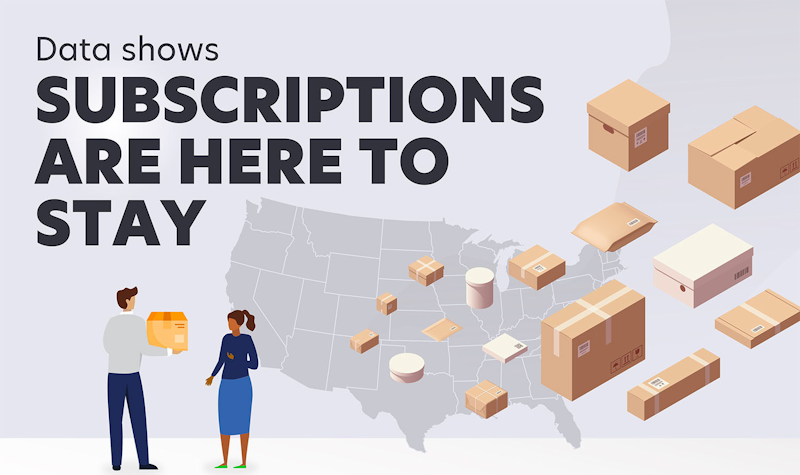The Quiet Rise of Subscription-based Services
Subscriptions are by no means unheard of today. Services like Netflix, Amazon, and DoorDash all feature popularly used monthly subscriptions. In fact, over half of all consumers in the United States use Amazon Prime. It’s no surprise then that...

Subscriptions are by no means unheard of today. Services like Netflix, Amazon, and DoorDash all feature popularly used monthly subscriptions. In fact, over half of all consumers in the United States use Amazon Prime. It’s no surprise then that subscription models are on the rise.
What can be surprising is exactly how popular they are today. Subscription model based companies are growing 3.7 times faster than the S&P 500. They’re quickly becoming an undeniable economic powerhouse. What this equates to, at the end of 2022, is 225 million subscriptions. When there’s only 61 million subscribers that creates an average of over nearly four subscriptions per subscriber.
These are staggering statistics. It seems that once subscription models become a part of one’s life, it becomes increasingly more common. Why is this though, what’s the appeal of subscription based models? First and foremost, they’re cost effective. Subscriptions have the unique perk of paying more now to pay less later.
This explains why subscription models aren’t expanding to everyone in the U.S. The reality is that it’s not going to be affordable to everyone. Even if it is cost effective, it’s still costly at the moment of purchase. Another big reason why subscription models are appealing is because of their convenience.
In fact, that’s the biggest appeal of subscriptions today. Every single popular subscription relies on this as a factor. Netflix brings more movies quicker than individually searching them out. Amazon Prime offers faster shipping for cheap. Unique novelty subscriptions like BirchBox just arrive at the doorstep, no work required. Even DoorDash and Instacart are providing things as basic as food more conveniently and quickly.
This convenience factor is a big part of why subscription models are starting to expand. Even as the cost effectiveness of subscriptions starts to drop, the convenience is just undeniable. The cherry on top of it all is how predictable subscriptions are. The payment is consistent, both in terms of amount and time frame. Using subscription models helps to make budgeting consistent and easy.
Another factor helping subscriptions boom are the new innovations being made. Now subscriptions aren’t just a monthly or yearly thing, they can be based on use. There are a few examples of how this can work. Replenishment models wait for something to run out before instantly providing more. This is helpful to reduce waste and to reduce prices. Meanwhile simple usage models will tailor the price to how often the product is used. This ensures that every dollar is clearly attached to something, but can be more pricey.
In practice all of these factors make subscriptions massive today. In particular, younger generations love subscription services. Convenience is a more highly valued commodity the younger the generation. Almost 40% of millennials are buying subscriptions, whereas that number plummets to below 10% for baby boomers. Gen Z, still being so young, has a lower percentage than millennials, but it is predicted to grow.
Finally there are two other factors which have been helping to skyrocket subscriptions. These are more extra credit than anything, but are still relevant to understanding subscriptions today. The first of these is the influence of the pandemic. During the pandemic subscription services were growing at an unpredictable rate. The hands-off and predictable model that subscriptions offer was very desirable in such an uncertain time.
Of course this effect has lessened as the pandemic moves further away, but it’s still a proof of concept. Subscriptions are safe, practical, and accessible. There’s one last factor missing from this equation though, one thing which brings it all together. Subscriptions, in their various forms, are fun.
While the convenience and the effective pricing are nice, for many consumers they just appreciate the novelty of subscription models. There’s something appealing about a randomized box that arrives every week. Buying a set of razors at the store just doesn’t have the same appeal as Dollar Shave Club does.
Subscription models are well marketed, trendy, and fun. This is a big part of why subscription models are moving into so many new spaces. There’s now plant subscriptions, science subscriptions, hunting subscriptions. Nowadays it doesn’t even have to make sense as a subscription because it can just be fun.
And those are the forces causing the rise of subscription based models today. There’s no assurance that this will last indefinitely. Perhaps they’re just trendy right now and soon enough they’ll be seen as outdated and impractical. Although looking at the data, that really doesn’t seem to be the case. There’s something appealing about subscriptions, or as has been discussed, a few appealing things.
They’re not for everyone, and they’re not going to replace every market under the sun, but they’re here to stay. After all, even if the novelty goes away, Amazon, Spotify, and Netflix really aren’t going anywhere. Certain industries really are tailored to a subscription based model. Now what’s left to be seen is which ones are immune to the appeal.
See the Full Infographic

 Lynk
Lynk 































